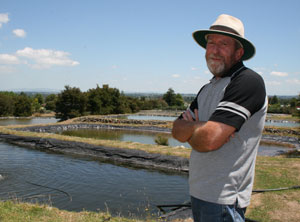People are somewhat fascinated by Murray Barker's job.
| Murray Barker wishes he had more time to appreciate the fish rather than working with them. |
'It's something a bit different… people are worse than cats, cats are inquisitive, people are more inquisitive.”
Working with up to 600,000 goldfish is certainly different.
It's a career Murray has developed from a humble operation to a thriving business which turns over 400,000-600,000 fish each year.
'People don't realise the scale,” says Murray's wife Sally.
Braeside Aquaria is a far cry from Murray's beginnings in the grocery trade some 20 years ago, with a customer who owned a goldfish farm and sought out a workmate - Murray.
Three years later he and wife Sally, along with two silent partners, took over the goldfish farming operation.
Untapped potential
'What the previous owner didn't realise was the vast untapped potential of the goldfish industry,” says Murray. 'So we bought it and started making small advances, then bigger advances, expanding it slowly.
'It was Stan's (the previous owner) idea, we just took it to a higher level.”
Braeside Aquaria was less than 5 percent of its size today – encompassing 15 acres, four sites, seven million gallons of water and 25 varieties of goldfish.
Murray says the business initially had five wholesale customers, but a shift of focus has seen them tap further into direct sales – targeting pet shops, garden centres, vets and aquarium retail businesses. Now, Braeside supplies 150 customers.
In good demand
'There was quite a bit of competition but over the last 10-15 years people have faded away, they don't build it up and stay there,” says Murray. 'There's a good demand for goldfish.”
The demand is in part driven by New Zealand being unable to import goldfish, due to a current disease status.
While the early years were challenging, Murray and Sally say learning from their errors and sticking with it has been rewarding.
'I've been a drifter most of my life, people take a bit of a shine to me and want me to do things with them. Goldfish was something that if done well, could give us a decent living, so I applied myself to it,” says Murray.
'Every mistake we made potentially can put you out of business, losses can be 100 percent.
'It comes down to experience being the best teacher. Remember your mistakes or learn from other peoples.”
Summer heat
Goldfish farming is not easy – particularly during summer when increased water temperature wreaks havoc, encouraging parasites, bacterial problems and preventing fish from keeping cool.
The Bakers try to prevent problems with regular water changes and running air into the ponds, which essentially doubles water capacity.
'It's not easy, in summer you just about have to sleep with one eye open – you are up against it, it's really difficult,” says Murray. 'If goldfish farming was easy, everyone would be doing it.
'In the first three or four seasons we nearly didn't get going. Man it was hard. We look back and think how did we survive.”
But gradually the business got going and after 12 years hard slog, it began to become a viable business.
Goldfish market
'You would think in a couple of years the market would be full,” says Murray.
However the commercial operation is thriving, with at least three daily courier orders heading out the door – thousands of fish a day destined for areas from Kaitaia to Invercargill.
'The couriers have made the business.”
Most goldfish take 12 weeks to mature and be ready for sale – priced from $1.50 each.
Having previously exhibited at the World Ornamental Fish Expo in Singapore during 1996, Murray and Sally's goldfish competed against the best in the world and came away with prizes.
Braeside Aquaria is now one of roughly five other goldfish breeders in New Zealand.
Sixty-nine 30ft ponds at the business's Te Aroha site is a far cry from the 30 ponds (20 of which were small in size) which Murray began with. He estimates there would have been roughly 30,000-40,000 fish farmed back then.
Bigger fish are farmed at the Wairakau and Paeroa farms.
Popular comets
While an assortment of exotic-looking goldfish are farmed by Murray, he says it's the comets – ordinary straight tale goldfish – which continue to be the most popular.
Murray says unfortunately getting caught up in the hum-drum of daily business does stop him appreciating the beauty of the fish.
'I do like goldfish, I just wish I had more time to appreciate the fish rather than working with them.”
By Vanessa Neems



0 comments
Leave a Comment
You must be logged in to make a comment.